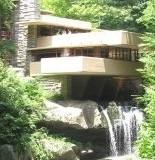Novella Excerpt by Kelcey Parker
Editor's Note: This month, TW features an excerpt from the first chapter of a novella in progress. Kelcey Parker sets Liliane’s Balcony at Fallingwater, the house designed by Frank Lloyd Wright for the Pittsburgh merchants E.J. and Liliane Kaufmann.
The novella begins on the night in September 1952 when Liliane Kaufmann overdosed on pain pills. Her story alternates with those of four contemporary tourists visiting Fallingwater, each of whom is dealing with a personal crisis. Their individual stories culminate on Liliane's famous overhanging balcony.
All artists occasionally put something outrageous in their works to get them noticed—signature pieces that guarantee their creators a succès de scandale. For Gertrude Stein it was deadening repetition, for Frank Gehry it has been undulating curves and titanium, for Picasso the distorted human forms in his Damoiselles d’Avignon and Guernica. In Fallingwater, I see two such signature pieces: the illusion of water coursing through the house, and Liliane’s oversailing balcony. — Franklin Toker, Fallingwater Rising
The rock ledges of a stone-quarry are a story and a longing to me. — Frank Lloyd Wright
Liliane strains to hear the falling water. She closes her eyes to open her ears to hear the water falling, for that is the point of the house, the architect had explained, to live with the waterfall. It was too plain merely to see the waterfall. One had to live with it, hear its voice, feel its pulse. But Liliane, in her bed, in early September, with the terrace door open despite the threat and scream of late-summer insects, cannot. She opens her ears wider and no waterfall. Insects. Ting ting of dishes downstairs. No waterfall.
And what of Stoops? Must one hear Stoops? Must one live with Stoops?
Grace. Grace is the name Liliane’s husband calls Stoops. Grace is across the world in California, but Liliane can hear her. Liliane can hear young Stoops Goldilocking through the rooms of the California house, claiming what’s not hers. Liliane doesn’t care a whit about the commissioned California house, which, all glass and chrome, is like an oversized display case at the department store. (No wonder her husband likes it so.) But a stooping nurse? Liliane hears her so clearly she wonders if Stoops is here now. It is easy enough to hide someone away at Bear Run. Liliane hardly recalls where all the servants scurry off to at night. Not that Stoops would stoop to servants’ quarters; Stoops would stow herself away in the husband’s room. Liliane winces, takes another pill for her pain.
Stoops handles her husband’s pain. “Where does it hurt, Mr. K? Here? Is that better?” Liliane hears Stoops nursing her husband, hears her husband say, “Yes, Grace, there, yes.” Liliane hears the first time Stoops calls him by his first name, hears the silence that follows, hears the knowing smiles.
The sounds are too much. Liliane is supposed to live with the waterfall, not with Stoops. She lifts herself to a sitting position and plants her feet firmly on the floor until the room stops Stooping. Stop. Another pill. A drink of water. The pill and the water fall together through her throat. She clutches the edge of the nightstand to pull herself up. Her body sways like a late-summer cattail in a gentle wind. Steady now, Liliane clasps the door’s latch and steps onto her balcony.
She must have floated across the stony platform surface. How else could she be here now at its edge, so far from the door she thought she was still clutching, leaning her torso over the low parapet to hear the waterfall. And there, below her, not so much like an old friend (of which she has many) but a best friend (of which she has none), yes, there it is: a moving surface, a moonlit triangle, hypotenused by the rock’s edge. That edge marks the point of transformation from stream to spray, from slipsong to scream. Schäumt er unmutig/Stufenweise/Zum Abgrund. She can hear Goethe’s words, Schubert’s chorus, but she can’t hear it, the water, the screaming spray. Darkness covers sight, not sound, yes? She looks up, away from the silent water, and hears the sharp whistle of a hawk perched somewhere in the surrounding fortress of trees, upside-down brooms that sweep the sky.
The sky is a constellation of pain pills. Liliane reaches out her hand and squeezes a cluster into her fist. She puts one in her mouth, swallows it, and thinks of water. Where is the voice?
The architect had strutted about the house as it neared completion, and, with the workers adding to the audience, pointed with his cane to this feature and that, informing them of each detail and design function. The one that always stuck with Liliane, that she experienced and understood more deeply as the years passed, was the relationship between outside and inside. The inside’s floors and walls are made of rough outdoor stone, quarried just downstream, and the rock of the fireplace (strange to remember how it was once outside, how they used to picnic on it) could not be contained; it spills into the main room. The “basement” is the stream itself. The low ceilings, the architect had said, create a feeling of protection and comfort from the outdoors, while the overhanging terraces can only be compared, he declared, to cliffs of the Romantic sublime. (Ragen Klippen!) How he proclaimed about his design. Would anyone tolerate a painter who explained and interpreted his own paintings so? She forgave him because he’d been right about all of it. Yes, she’d quibbled with him over the lighting, over a few pieces of furniture, a rug here and there; it was her house, after all. Still, she wanted to tell him: Don’t you know? The house speaks for itself.
But its language was not language at all. Music, perhaps, chords of concrete, stone, glass; the melody: falling water.
She nonetheless understood his need to describe and define the house for the workers, the press, the visitors—those who had to absorb its details quickly, those who could not live with the waterfall but only admire the house floating above it. Occasionally over the years she would pause to ponder the fact that she and her husband and son were the only ones in the world who experienced the house as a house. The servants experienced it as a workplace. Visitors experienced it as temporary guests; photographers as photographers; scholars as scholars. She experienced it weekend after weekend as home.
After the scaffolding was removed and the house was complete, Liliane could imagine that it had simply grown up from the water’s edge like a living thing, like one of her rare orchids back at Fox Chapel. Her husband preferred to think in terms of violence, of the rumble of rocks at a fault line. (As if an earthquake does anything but destroy.) The architect said: think of a bird’s nest. Organic order, he said, dramatic refuge.
Now she is at the house’s farthest edge; her white linen gown flaps in the wind, and a sudden September chill reaches up and grabs her legs. One question she has always pondered: if one is on the balcony, is one inside or outside? The breeze says: outside. But the balcony is not an exposed rock’s edge; it’s part of the house, designed by the architect. Behind her now is her room, its warm glow. The French doors are open and the light spills onto the stone-patterned ground. The architect had been so clever the way he brought the outdoors in and the indoors out, dissolving the boundaries of the two.
But what, she would like to know, does one do when there is a Stoop at the entrance to a house? When a very prominent Stoop divides the indoors from the outdoors? Is there an architectural solution to that? She hears a bullfrog, but no answer, no waterfall. It is the contrast between inside and outside that she can no longer abide. Her inside, her outside. Outside, she is the proud Mrs. Kaufmann, who owns a department store, travels the world, patronizes the arts, and rules over the famous house. Inside she is withered, neglected, scorned.
Even when she returns to Pittsburgh, attends board meetings, assesses inventory, and sleeps in the downtown flat or the Fox Chapel house, she hears the white noise of the waterfall. Is that what the architect meant when he said you will live with the waterfall? Had he meant it will never leave you, no matter where you go? Des Menschen Seele/Gleicht dem Wasser:/Von Himmel kommt es,/Zum Himmel steigt es,/Und wieder nieder/Zur Erde muss es,/Ewig wechselnd. Where has it gone?
The cantilevered balcony stirs and settles, presses an indiscernible measure heavier on the living room below. Liliane knows that gravity will get the better of it someday; it will Stoop. Even houses such as this are not immortal. She plucks another pain pill from the sky.
You will live with the waterfall, the architect had said.
At last, at last—as if someone has switched on the amplifiers—she hears its familiar familial voice cry out to her.
And die with me, the waterfall says.
Kelcey Parker is the author of For Sale By Owner, a collection of stories forthcoming from Kore Press in February 2011. Her fiction and nonfiction has appeared in Indiana Review, Western Humanities Review, Bellingham Review, Santa Monica Review, Redivider, Third Coast, and twice in Image.
She has a Ph.D. in Literature and Creative Writing from the University of Cincinnati and currently lives in Northern Indiana, where she is an assistant professor at Indiana University South Bend. She blogs at Ph.D. in Creative Writing.
Before I began, I resisted, on all sorts of grounds: blogs are icky, too personal; blogs are solipsistic; blogs are boring. Except they’re not. — TW Interview with Kelcey Parker


